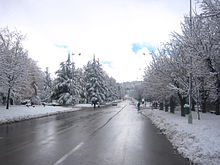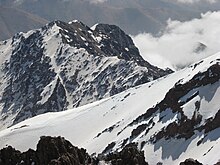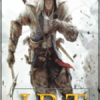Posts posted by Irt Hercules
-
-
-
-
Morocco, officially theKingdom of Morocco, is a country in the Maghreb region ofNorth Africa. Geographically, Morocco is characterized by a rugged mountainous interior and large portions of desert. It is one of only three countries (with Spain and France) to have both Atlantic and Mediterranean coastlines. The Arabic name al-Mamlakah al-Maghribiyah (Arabic: المملكة المغربية, meaning "The Western Kingdom") and Al-Maghrib (Arabic: المغرب, meaning "The West") are commonly used as alternate names.
Morocco has a po[CENSORED]tion of over 33.8 million and an area of 446,550 km2 (172,410 sq mi). Its political capital is Rabat, although the largest city is Casablanca; other major cities includeMarrakesh, Tangier, Tetouan, Salé, Fes, Agadir, Meknes, Oujda,Kenitra, and Nador. A historically prominent regional power, Morocco has a history of independence not shared by its neighbours. Its distinct culture is a blend of Arab, indigenous Berber, Sub-Saharan African, and European influences.
Morocco claims the non-self-governing territory of Western Sahara as its Southern Provinces. Morocco annexed the territory in 1975, leading to a guerrilla war with indigenous forces until a cease-fire in 1991. Peace processes have thus far failed to break the political deadlock.
Morocco is a constitutional monarchy with an elected parliament. The King of Morocco holds vast executive and legislative powers, especially over the military, foreign policy and religious affairs.Executive power is exercised by the government, while legislative power is vested in both the government and the two chambers of parliament, the Assembly of Representatives and the Assembly of Councillors. The king can issue decrees called dahirs which have the force of law. He can also dissolve the parliament after consulting the Prime Minister and the president of the Constitutional court.
Morocco's predominant religion is Islam, while the official languages are Berber and Arabic. Moroccan Arabic, referred to as Darija, and French are also widely spoken. Morocco is an influential member of the Arab League and a part of the Union for the Mediterranean. It has the sixth-largest economy in Africa.
Early Islamic era
In 670 AD, the first Islamic conquest of the North African coastal plain took place under Uqba ibn Nafi, a general serving under the Umayyads ofDamascus. The Umayyad Muslims brought their language, their system of government, and Islam to Morocco. Many of the Berbers slowly converted to Islam, mostly after Arab rule had receded. The first independent Muslim state in the area of modern Morocco was the Kingdom of Nekor, an emirate in theRif Mountains. It was founded by Salih I ibn Mansur in 710, as a client state to the Rashidun Caliphate. After the outbreak of the Great Berber Revolt in 739, the Berbers formed other independent states such as the Miknasa of Sijilmasaand the Barghawata.
According to medieval legend, Idris ibn Abdallah had fled to Morocco after the Abbasids' massacre of his tribe in Iraq. He convinced the Awraba Berber tribes to break their allegiance to the distant Abbasid caliphs in Baghdad and he founded the Idrisid Dynasty in 788. The Idrisids established Fes as their capital and Morocco became a centre of Muslim learning and a major regional power. The Idrissids were ousted in 927 by the Fatimid Caliphate and their Miknasa allies. After Miknasa broke off relations with the Fatimids in 932, they were removed from power by theMaghrawa of Sijilmasa in 980.
French and Spanish protectorates
Main articles: French Morocco and Spanish Protectorate in MoroccoAs Europe industrialized, North Africa was increasingly prized for its potential for colonization. France showed a strong interest in Morocco as early as 1830, not only to protect the border of its Algerian territory, but also because of the strategic position of Morocco on two oceans.[29] In 1860, a dispute over Spain's Ceuta enclave led Spain to declare war. Victorious Spain won a further enclave and an enlarged Ceuta in the settlement. In 1884, Spain created a protectorate in the coastal areas of Morocco.
In 1904, France and Spain carved out zones of influence in Morocco. Recognition by the United Kingdom of France's sphere of influence provoked a strong reaction from the German Empire; and a crisis loomed in 1905. The matter was resolved at the Algeciras Conference in 1906. The Agadir Crisisincreased tensions between European powers. The 1912 Treaty of Fez made Morocco a protectorate of France, and triggered the 1912 Fes riots.[30] Spain continued to operate its coastal protectorate. By the same treaty, Spain assumed the role of protecting power over the northern and southern Saharanzones.[31]
Tens of thousands of colonists entered Morocco. Some bought up large amounts of the rich agricultural land, others organized the exploitation and modernization of mines and harbours. Interest groups that formed among these elements continually pressured France to increase its control over Morocco – a control which was also made necessary by the continuous wars among Moroccan tribes, part of which had taken sides with the French since the beginning of the conquest. Governor general, Marshall Hubert Lyautey, sincerely admired Moroccan culture and succeeded in imposing a joint Moroccan-French administration, while creating a modern school system. Several divisions of Moroccan soldiers (Goumiers or regular troops and officers) served in the French army in both World War I and World War II, and in the Spanish Nationalist Army in the Spanish Civil War and after (Regulares).[32] The institution of slavery was abolished in 1925.[33]
Between 1921 and 1926, a Berber uprising in the Rif Mountains, led by Abd el-Krim, led to the establishment of the Republic of the Rif. The rebellion was eventually suppressed by French and Spanish troops.
In 1943, the Istiqlal Party (Independence Party) was founded to press for independence, with discreet US support. That party subsequently provided most of the leadership for the nationalist movement.
France's exile of Sultan Mohammed V in 1953 to Madagascar and his replacement by the unpo[CENSORED]r Mohammed Ben Aarafa sparked active opposition to the French and Spanish protectorates. The most notable violence occurred in Oujda where Moroccans attacked French and other European residents in the streets. France allowed Mohammed V to return in 1955, and the negotiations that led to Moroccan independence began the following year.[34] In March 1956 the French protectorate was ended and Morocco regained its independence from France as the "Kingdom of Morocco". A month later Spain ceded most of its protectorate in Northern Morocco to the new state but kept its two coastal enclaves (Ceuta and Melilla) on the Mediterranean coast. Sultan Mohammed became king in 1957.
Reign of King Mohammed VI
Main article: Mohammed VIKing Hassan II died in 1999 and was succeeded by his son, Mohammed VI. He is a cautious modernizer who has introduced some economic and social liberalization.[37]
King Mohammed paid a controversial visit to the Western Sahara in 2002. Morocco unveiled an autonomy blueprint for Western Sahara to the United Nations in 2007. The Polisario rejected the plan and put forward its own proposal. Morocco and the Polisario Front held UN-sponsored talks in New York but failed to come to any agreement. In 2010, security forces stormed a protest camp in the Western Sahara, triggering violent demonstrations in the regional capitalEl Aaiún.
In 2002, Morocco and Spain agreed to a US-brokered resolution over the disputed island of Perejil. Spanish troops had taken the normally uninhabited island after Moroccan soldiers landed on it and set up tents and a flag. There were renewed tensions in 2005 as hundreds of African migrants tried to storm the borders of the Spanish enclaves of Melilla and Ceuta. Morocco deported hundreds of the illegal migrants. In 2006 the Spanish Premier Zapatero visited Spanish enclaves. He was the first Spanish leader in 25 years to make an official visit to the territories. The following year, Spanish King Juan Carlos visited Ceuta and Melilla, further angering Morocco which demanded control of the enclaves.
In February 2003, a Casablanca court jailed three Saudi members of al-Qaeda for 10 years after they were accused of plotting to attack US and British warships in the Straits of Gibraltar. Three months later, more than 40 people were killed in the 2003 Casablanca bombings, when suicide bombers attacked several sites in Casablanca, including a Spanish restaurant and Jewish community centre.
Those responsible were believed to be Salafiya Jihadiya adherents linked to the Moroccan Islamic Combatant Group. One of those extremists was Nourredine Nafia, leader of the GICM (Moroccan Islamic Combatant Group), who was sentenced to 20 years in prison for his role in the attacks.
In the 2007 Casablanca bombings, three suspected suicide bombers blew themselves up, a few weeks after a suicide blast in an internet cafe that injured three. More than 40 people were given long prison sentences for this bombing. Two suicide bombers blew themselves up outside the US diplomatic offices in Casablanca
. The current King of Morocco,Mohammed VI.
The current King of Morocco,Mohammed VI.Some pictures of best places in Morocco
 Koutoubia Mosque in Marrakech
Koutoubia Mosque in Marrakech  Ouzoud Falls.
Ouzoud Falls.  Menara gardens in sunset
Menara gardens in sunset  Ifrane, City
Ifrane, City  Moroccan Sahara
Moroccan Sahara  Western High Atlas
Western High Atlas  Toubkal, the highest peak in North Africa, at 4,167 m
Toubkal, the highest peak in North Africa, at 4,167 m -
 1
1
-
-
-
-
-
-
BY : I-R-T



-
 2
2
-
-
-
 This is the gift of 2 to coffee
This is the gift of 2 to coffee 
By: I.R.T



Y.L.M -Abo Al RisheQ- Pepsi. Snowman



KAAARIM Nightmare [L]!O[N] [K]!Lle[R] -MaR!o-



LeO- KaPii Maxsven ZAKARIA 201



NeO-
Sooon!!!K
[H]asHem[H][K]!||e[R]
------------------------------------------------------------------------------------------------------------------
To communicate with me : Click here
Click here 
-
 1
1
-
-
 These images a small gift for gamers perfectzm
These images a small gift for gamers perfectzm 
by : I.R.T



wirwir ana-heek Th3 T!g3R ALGEIRANO



V-E-V-O. BAROTO LUCK- NeO-


DZ hynter YASSIN
-
 6
6
-























Gallery I.R.T HERCUOLES
in Weekly Songs ♪ ♫
Posted